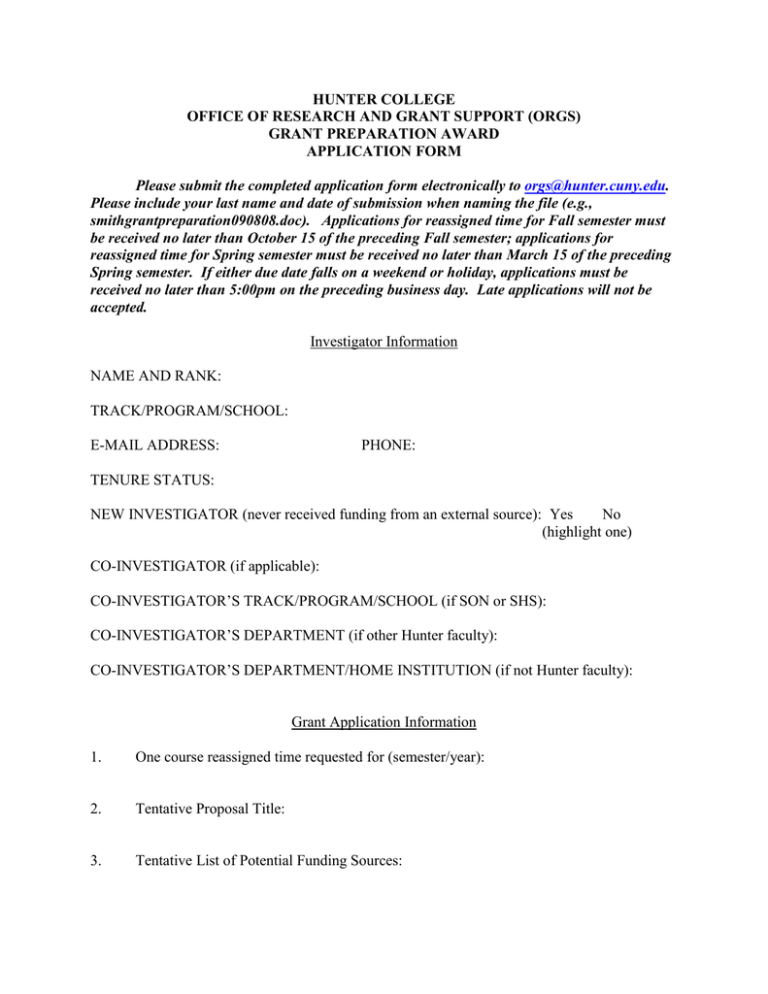HUNTER COLLEGE OFFICE OF RESEARCH AND GRANT SUPPORT (ORGS) GRANT PREPARATION AWARD
advertisement

HUNTER COLLEGE OFFICE OF RESEARCH AND GRANT SUPPORT (ORGS) GRANT PREPARATION AWARD APPLICATION FORM Please submit the completed application form electronically to orgs@hunter.cuny.edu. Please include your last name and date of submission when naming the file (e.g., smithgrantpreparation090808.doc). Applications for reassigned time for Fall semester must be received no later than October 15 of the preceding Fall semester; applications for reassigned time for Spring semester must be received no later than March 15 of the preceding Spring semester. If either due date falls on a weekend or holiday, applications must be received no later than 5:00pm on the preceding business day. Late applications will not be accepted. Investigator Information NAME AND RANK: TRACK/PROGRAM/SCHOOL: E-MAIL ADDRESS: PHONE: TENURE STATUS: NEW INVESTIGATOR (never received funding from an external source): Yes No (highlight one) CO-INVESTIGATOR (if applicable): CO-INVESTIGATOR’S TRACK/PROGRAM/SCHOOL (if SON or SHS): CO-INVESTIGATOR’S DEPARTMENT (if other Hunter faculty): CO-INVESTIGATOR’S DEPARTMENT/HOME INSTITUTION (if not Hunter faculty): Grant Application Information 1. One course reassigned time requested for (semester/year): 2. Tentative Proposal Title: 3. Tentative List of Potential Funding Sources: Name: ______________________________ 4. Track Coordinator Electronic Signature (signifying approval): 5. Program Director Electronic Signature (signifying approval): 6. Dean Electronic Signature (signifying approval): 7. Description of project or research to be developed into a grant proposal: (application not to exceed 4 pages, excluding cover page, protection of human subjects, vertebrate animals and select agent research) a. Specific Aims: (recommended .25-.5 page) b. Background and Significance: (recommended .75 page) c. Preliminary Studies/Organizational Capacity: (recommended .5 page) d. Design, Methods, Evaluation: (recommended 1.5 pages) e. Relevance to Career Plan for External Funding: (recommended .25 page) f. Plans for Protection of Human Subjects: (recommended 1 page; write NA if no human subjects are involved; for more detailed information about Human Subjects, including federal regulations, please visit the website of the National Institutes of Health Office of Human Subjects Research) Please note: Research that involves obtaining private information or human biological specimens (such as blood and tissue samples) that can be linked by the investigator(s) to living individuals is considered human subjects research. Research that involves only coded private information/data or coded human biological specimens may or may not constitute human subjects research under the HHS human subjects regulations (45 CFR 46). If you have any questions about whether or not your proposed research will involve human subjects, please speak with Bea Krauss, ORGS’ Executive Director. 2 Name: ______________________________ Involvement of human subjects: Characteristics of population: (e.g., anticipated age, gender, racial/ethnic composition, size, etc.) Inclusion and exclusion criteria: (include rationale) Vulnerable populations: (e.g., prisoners, children) Sources of materials: (e.g., interview, tissue samples) Potential risks: (e.g., emotional upset, breach of confidentiality) Protections against risks: (e.g., training of staff, advance directives for emergencies) Benefits: (e.g., payments to participants, education of participants) Importance of knowledge to be gained: (rationale for risk/knowledge benefit ratio) g. Inclusion of Women and Minorities: (recommended .25 page; if you are using human subjects, you must answer these questions; if you are not using human subjects, write NA; for more detailed information, including federal regulations, please visit the website of the National Institutes of Health, Inclusion of Women and Minorities as Participants in Research) Subject selection criteria and rationale for selection of sex/gender and racial/ethnic group members in terms of scientific objectives and proposed study design: (may include, but is not limited to, information on the population characteristics of the disease or condition under study) Rationale for proposed exclusion of any sex/gender or racial/ethnic group: 3 Name: ______________________________ Proposed outreach programs for recruiting sex/gender and racial/ethnic group members as subjects: Targeted/Planned Enrollment Table (click here to download table; this table is provided to assist you in the grant development process) h. Inclusion of Children (individuals under the age of 21 years): (recommended .25 page; if you are using human subjects, you must answer these questions; if you are not using human subjects, write NA; for more detailed information, including federal regulations, please visit the website of the National Institutes of Health, Inclusion of Children Policy Implementation) Describe plans to include children (see “Additional Protections for Children Involved as Subjects in Research” (45 CFR Part 46 Subpart D) and address above in “Involvement of Human Subjects” and “Protection against Risks”) or justification if children will be excluded (see Justifications for Exclusion of Children): Rationale for selecting a specific age range of children: Expertise of the investigative team for dealing with children at the ages included: Appropriateness of available facilities to accommodate children: Inclusion of a sufficient number of children to contribute to a meaningful analysis relative to the purpose of the study: i. Vertebrate Animals: Will the proposed research use vertebrate animals? Yes No (highlight one; if yes, click here to download the Vertebrate Animal Form; this form is provided to assist you in the grant development process.) For information about animal welfare policy requirements, Institutional Animal Care and Use Committees (IACUC), and Animal Welfare Assurances, please visit the website of the Office of Laboratory Animal Welfare (OLAW). 4 Name: ______________________________ j. Select Agent Research: Will the proposed research use select agents? Yes No (highlight one; if yes, click here to download the Select Agent Research Form; this form is provided to assist you in the grant development process.) Select Agents are hazardous biological agents and toxins that have been identified by the United States Department of Health and Human Services or the United States Department of Agriculture as having the potential to pose a severe threat to public health and safety, to animal and plant health, or to animal and plant products. CDC maintains a list of these agents. See http://www.cdc.gov/od/sap/docs/salist.pdf. 5
